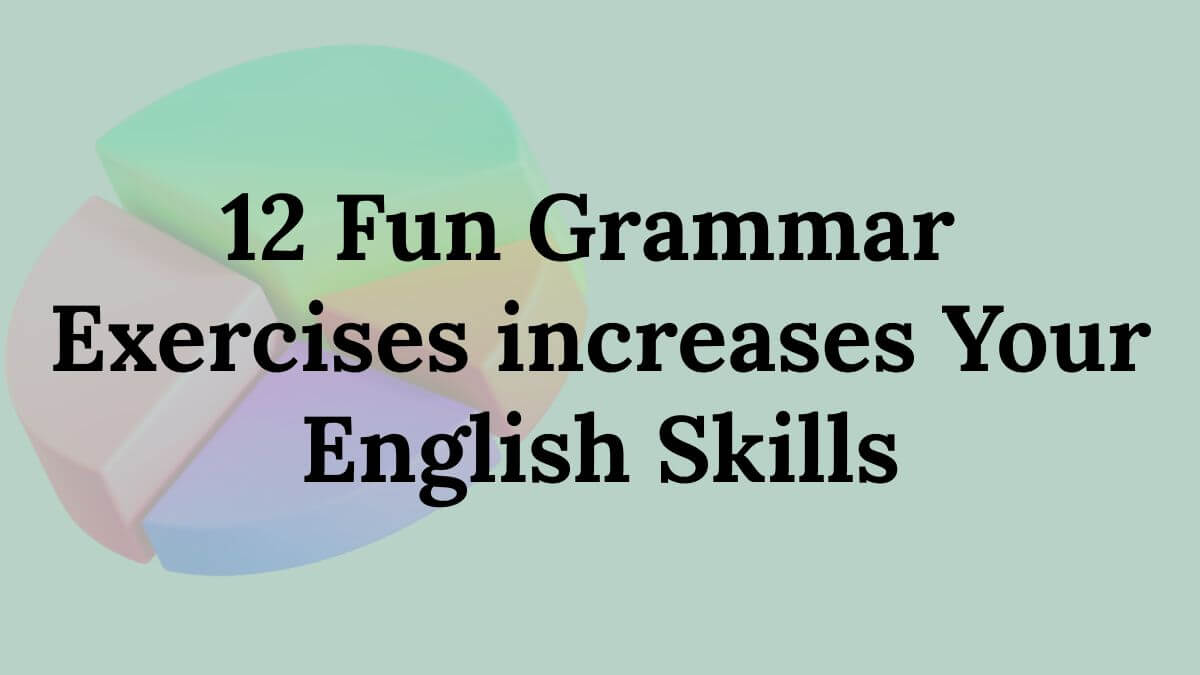Fun Grammar Exercises can be the perfect solution if you’re tired of boring grammar drills. Or maybe you’re teaching and your students are zoning out during lessons?
Don’t worry—learning grammar doesn’t have to be dull. Whether you’re an English learner or an educator, estos 12 engaging grammar exercises will challenge your skills, reveal your weak spots, and make grammar practice surprisingly enjoyable.
Let’s dive into some fun, interactive, and effective grammar workouts!
Why fun grammar exercises
Learning grammar doesn’t have to be boring! Fun grammar exercises keep learners engaged, make complex rules easier to understand, and help with long-term retention. When grammar feels like a game, students are more motivated to practice—and that leads to better results.
1. Sentence Shuffle Challenge
How it works:
Give students a jumbled sentence and ask them to rearrange it into the correct form.
Example:
Jumbled: yesterday / went / I / store / to / the
Correct: I went to the store yesterday.
Why it helps:
It improves word order understanding and sentence structure skills.
2. Spot the Error Game
How it works:
Present sentences with one grammar mistake each. Learners must identify and correct the errors.
Example:
Incorrect: She don’t like coffee.
Correct: She doesn’t like coffee.
Bonus tip: Make it a timed game for added excitement.
3. Verb Tense Time Travel
How it works:
Give students base sentences and ask them to convert them into different tenses.
Example:
Base: She writes emails every morning.
Past simple: She writes emails every morning.
Future continuous: She will be writing emails every morning.
Focus: Reinforces tense knowledge and usage.
Read More About: Common Mistakes with Auxiliary and Modal Verbs
4. Grammar Bingo
How it works:
Create bingo cards filled with grammar terms (e.g., “past perfect,” “conjunction,” “preposition”). Read clues, and students mark the matching term.
Why it’s great:
Fun for classrooms and reinforces grammar terminology.
5. Fill-in-the-Blank Stories
How it works:
Give learners short stories with blanks where key grammar elements are missing (articles, verbs, prepositions).
Example:
She ___ (go) to the market and ___ (buy) some apples.
Goal: Encourages grammar in context.
6. Pronoun Swap Activity
How it works:
Ask learners to replace nouns with appropriate pronouns in a paragraph.
Example:
Original: Mary saw John and Mary waved to John.
Revised: She saw him and she waved to him.
Why it’s useful:
Helps eliminate repetition and build fluency.
7. Adjective Adventure
How it works:
Give learners a basic sentence and ask them to expand it using adjectives.
Example:
Basic: The dog barked.
Expanded: The large, angry dog barked loudly.
Pro tip: Turn it into a competition—who can make the most descriptive sentence?
8. Conjunction Construction
How it works:
Provide two short sentences. Students must join them using coordinating or subordinating conjunctions.
Example:
Sentences: I was tired. I finished my work.
Answer: I was tired, but I finished my work.
9. Passive Voice Detective
How it works:
Give sentences and ask whether they are active or passive voice. Then ask learners to switch them.
Example:
Active: The man prepares the meal.
Passive: The meal is prepared by the man.
10. Question Creation Relay
How it works:
Give an answer and ask students to create a grammatically correct question.
Example:
Answer: At 5 o’clock.
Possible question: What time did she arrive?
Benefits:
Improves question formation and logical thinking.
11. Preposition Maze
How it works:
Design a visual maze or map. Students must use the correct prepositions to describe a route or position.
Example:
The cat is ___ the table. (under/on/in)
Visual learners love this one!
12. “Would You Rather” Grammar Edition
How it works:
Ask students quirky “Would you rather…” questions and have them explain their answers in full sentences using proper grammar.
Example:
Would you rather eat broccoli every day or never watch TV again?
Answer: I would rather eat broccoli every day because I love watching TV.
Why These Grammar Exercises Work
These activities are designed to activate real language use, not just memorization. They encourage:
- Creative thinking.
- Real-life application.
- Group interaction (ideal for classrooms).
- A positive association with grammar.
By integrating these into your routine, grammar becomes less of a chore and more of an adventure.
Conclusion
Grammar doesn’t have to be dry or intimidating. With a few clever tweaks and a bit of creativity, you can turn grammar practice into something students and self-learners actually look forward to. Try mixing and matching these exercises each week to keep things fresh.
Whether you’re brushing up your own skills or guiding learners, these grammar games are guaranteed to sharpen minds and boost confidence.
